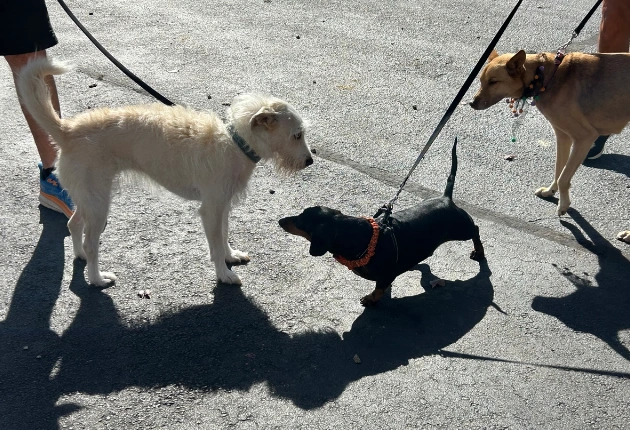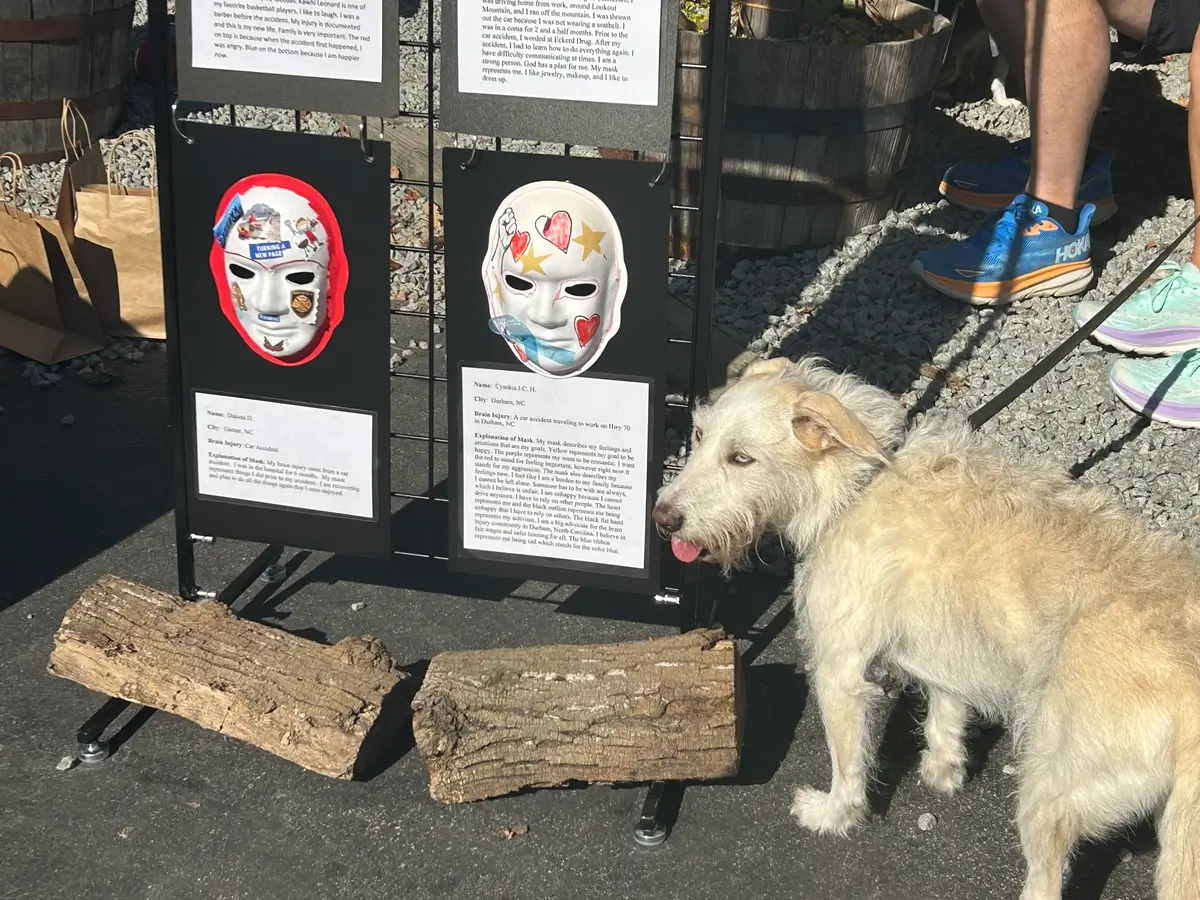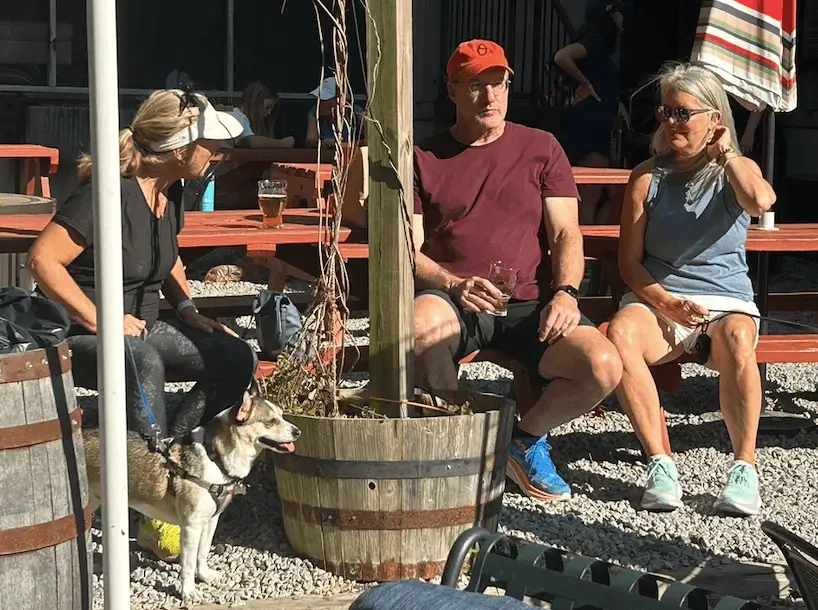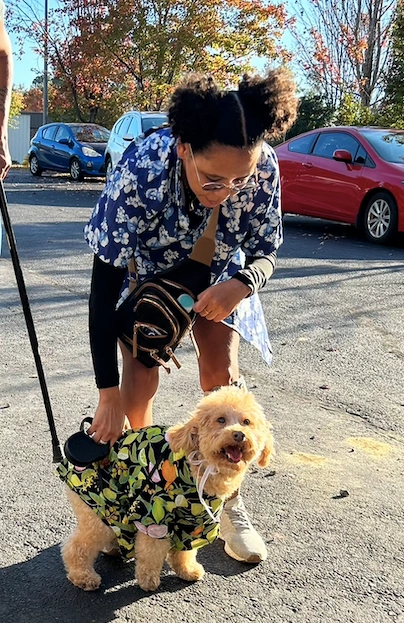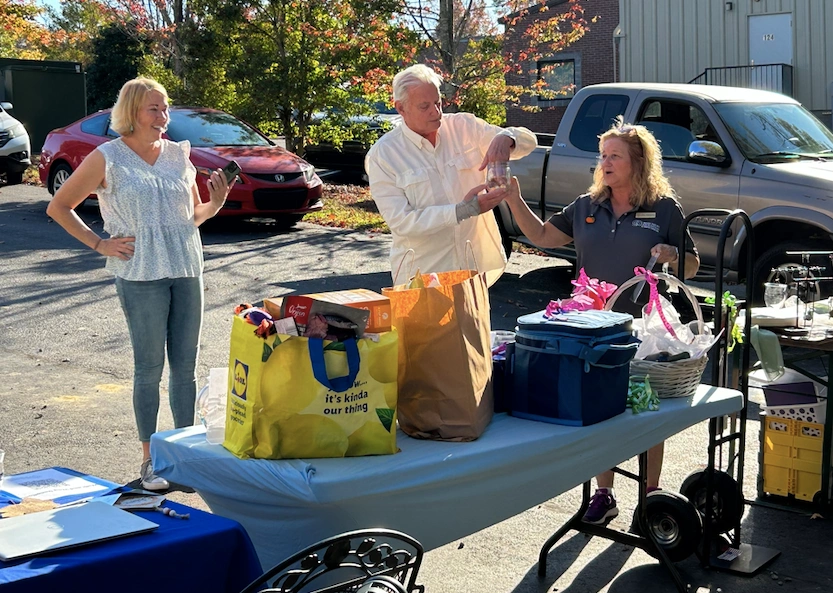On the back patio area at Bombshell Brewery, the sunrays filtered through the brilliant orange and red leaves while dogs frolicked in and out of the pools of sunshine. The dogs were happy to play in the leaves and were unaware they were gathered for a higher purpose. Dog owners had come to do more than sip beer – they came to walk with their dogs to raise awareness for brain injuries.
The Third Annual Walk-n-Wag for Brain Injury was held on a gorgeous October day to support the Brain Injury Association of North Carolina (BIANC). The afternoon event consisted of a dog-themed raffle, door prizes, a doggy costume contest, an art display, and a short stroll around town, all while educating people about brain injury awareness.
How BIANC Provides Hope For Brain Injury Survivors & Their Families
For 40 years, the Brain Injury Association of North Carolina has offered help, hope, and a voice for people with brain injury and their families through outreach, advocacy, education, training, a podcast, classes, art, resources, support groups, and volunteer opportunities for residents in North Carolina. According to BIANC, even though 78,775 people in North Carolina are reported to have sustained a traumatic brain injury (TBI) in one year’s time, estimated reports are more than 200,000 people living with a long-term disability related to a TBI.
Executive Director Daniel Pietrzak described how the organization serves those with brain injuries and beyond. Pietzrak noted, “We work with legislators by explaining the changes we need to see using data. Staff and volunteers work with providers, firefighters, EMS, police, and others to help train and educate them on how to recognize the signs of brain injury that other issues may mask. For example, comorbidity issues can compound the effects of a brain injury, such as when paired with mental health issues, substance abuse, medication side effects, and more.”
Programs geared toward survivors provide camaraderie, support, and learning opportunities for growth. “We have support groups run by survivors because we want them to be the ones controlling their own destiny while supporting them through education,” Pietzrak explained. BIANC also participates in the Unmasking Brain Injury Project where survivors paint and decorate masks sharing their personal journeys that are displayed across the state for awareness and advocacy.
Mavi checks out the masks brain injury survivors have created as part of the Unmasking Brain Injury Project
It’s personal for some volunteers and attendees
Brain injuries affect those beyond the people who experience one – they also touch the lives of families, friends, neighbors, and the community.
Karee White, Chair Emerita of BIANC, is a volunteer with a personal connection to brain injuries. She was inspired to work with the Association through her oldest daughter, a wounded warrior involved in a military accident ten years ago who now suffers from a brain injury. “I wanted to get to the root of what caused her injury and also advocate for all the individuals like her that live in North Carolina, and BIANC gave me that opportunity,” she said.
Another participant came to show support for those caring for people with brain injuries. Attendee Sherry brought her beautiful dog from Turkey named Mavi to participate in the walk by supporting White’s family. Sherry has known White since their children were together in school and as neighbors. She used to read to White’s daughter once a week growing up and even attended her wedding. Sherry has been a friend to the family before, during, and after White’s daughter’s injury.
Sherry explained, “The Whites have always had dogs that would be right there beside us when I read to her. They bring us comfort. There’s something peaceful about having a dog with you, and you can tell them anything. They are the world’s greatest listener and make our lives better, especially for people with brain injuries.”
Sherry (right) chats with other Walk-N-Wag participants
Effects of Brain Injuries
Direct symptoms of brain injuries can be as mild as a headache that clears up after a particularly harsh tackle or as severe as major trauma. Brain injury sufferers may experience a variety of symptoms depending on the type and nature of the brain injury, such as a change in moods, cognitive difficulties, balance and mobility issues, or being minimally conscious.
However, brain injuries aren’t the only cause of symptoms. “It’s not the brain injury itself that will get you, it’s sometimes those secondary and tertiary reactions to the brain injury. For example, my daughter’s pulmonary system is really suppressed, and she is more prone to aspiration, pneumonia, and respiratory issues,” stated White.
Who can suffer from brain injuries?
A large percentage of people BIANC serves are veterans with traumatic brain injuries, but a variety of incidents can cause brain injuries in civilians as well. Some events possibly resulting in brain injuries range from mild to severe and include:
- Concussions from contact sports
- Accidents involving a head injury
- Fire-related injury
- Car accidents
- Birth trauma
- Explosions
- Infections
- Illnesses
- Assault
How many US Veterans suffer from TBIs?
The largest population of those suffering from traumatic brain injuries are military service members and veterans. Jennifer J. Shiroff et al. (2022) conducted a study published in Psychiatric Research and Clinical Practice interviewing veterans utilizing service dogs as a treatment modality for Post-Traumatic Stress Disorder and/or Traumatic Brain Injuries. Researchers noted that between 2000-2016, 352,612 service members were diagnosed with TBIs and 21,000 service members suffer a TBI annually.
Through organizations like BIANC coupled with canine companionship, whether by being an emotional support dog or a trained service dog, our canine friends can assist those with brain injuries in several ways.
How Dogs Help Those Living With A Brain Injury
Dogs can play a crucial role in enhancing and improving the quality of life for those suffering from brain injuries. They can improve communication, shatter barriers, and create a connection to the community to help build relationships.
Through companionship
Living with a traumatic brain injury can be socially isolating and lonely. Dogs can also provide unconditional love and lend a velvety ear to their affected companions. “Lots of folks with brain injuries can be alone sometimes because people can’t be with them all the time,” Pietrzak said. “It’s nice to have companionship and someone to talk to. Brain injury or not, we all talk to our dogs.”
Costume contest winner
Becoming a service dog
Several organizations train service dogs to help transform the lives of people living with brain injuries. They can do physical tasks assisting with mobility and coordination, help with speech and communication in articulation by knowing a variety of commands, and assist with memory issues such as reminding someone when to take medication.
Programs offering service dogs for traumatic brain injuries will extensively train eligible dogs from the time they are puppies through about 2 years old. By the time puppies are a year old, they already know several commands. When a dog is matched with a recipient and companion training has begun, the service dog has most likely clocked hundreds if not thousands of hours of training and socialization.
However, these organizations don’t just train the dogs – they also train the human recipients. Brain injury sufferers usually go through extensive training themselves to learn commands, practice real-world situations, and become comfortable in their new lives with their companions. Being set up for success through thorough training allows the human-dog bond to form deeper and more effective assistance.
In addition to helping with life skills, some dogs are also trained to mitigate medical events. “Certain trained dogs can detect when a seizure is starting, thus helping their owner get to a safe place and even support him or her throughout the seizure, then remain with them or go out and get help as they are trained to do,” notes US Service Animals. A dog’s sense of smell is up to 10,000 times stronger than a human’s and contains over 300,000 olfactory receptors, so it’s no wonder dogs can smell chemical changes in the body before medical events occur.
Chair Emerita Karee White and Program Director Libby Wilhelmson watch as a veteran draws raffle prize winners
The Future of Dogs Assisting Brain Injury Sufferers
On the Making Connections podcast hosted by BIANC, interviewee Pat Hairston from Four Paws and a Wake Up-NC noted the need for more dogs to be trained for non-service dogs since many efforts focus on veterans, but there are still not enough trained service dogs for everyone who would benefit from their presence. For those who already own a service dog, Four Paws and a Wake Up-NC offers a “dedicated animal-assisted therapy program with volunteers and their dogs trained to work with people in our community.”
Hairston noted while service dogs receiving training for veterans has increased in the last decade, “having a strong diagnostic package and documentation to submit to an organization is lacking in the non-veteran community. There is not a defined battery of tests that can tell you this diagnosis was made based on X, Y, and Z.” The civilian population is continuing to raise awareness to have dogs accessible to everyone with brain injuries and their families regardless of diagnoses when formal assessments do not currently exist.
Finding A Furry Friend For Support
Connecting with fellow dog lovers to make a difference can be a wonderful and effective way to raise support for important causes. Through a canine partner, dogs can enhance the lives of brain injury sufferers in invaluable ways. “The best part about a furry friend in helping someone living with a brain injury is when they cause you to get away from the regrets of the past, worries of the future, and present of the moment,” White explained. “Petting a dog takes your mind away from all that and gives you bliss and respite in a state of suffering.”
Pawrade would love to assist people looking for companion or service animals for those with brain injuries or anyone considering a forever friend. We partner with ethical breeders who keep the well-being of puppies at the forefront when preparing them to go to loving homes. Contact one of our Puppy Concierges to discuss adopting puppies for sale that will meet your particular needs.

